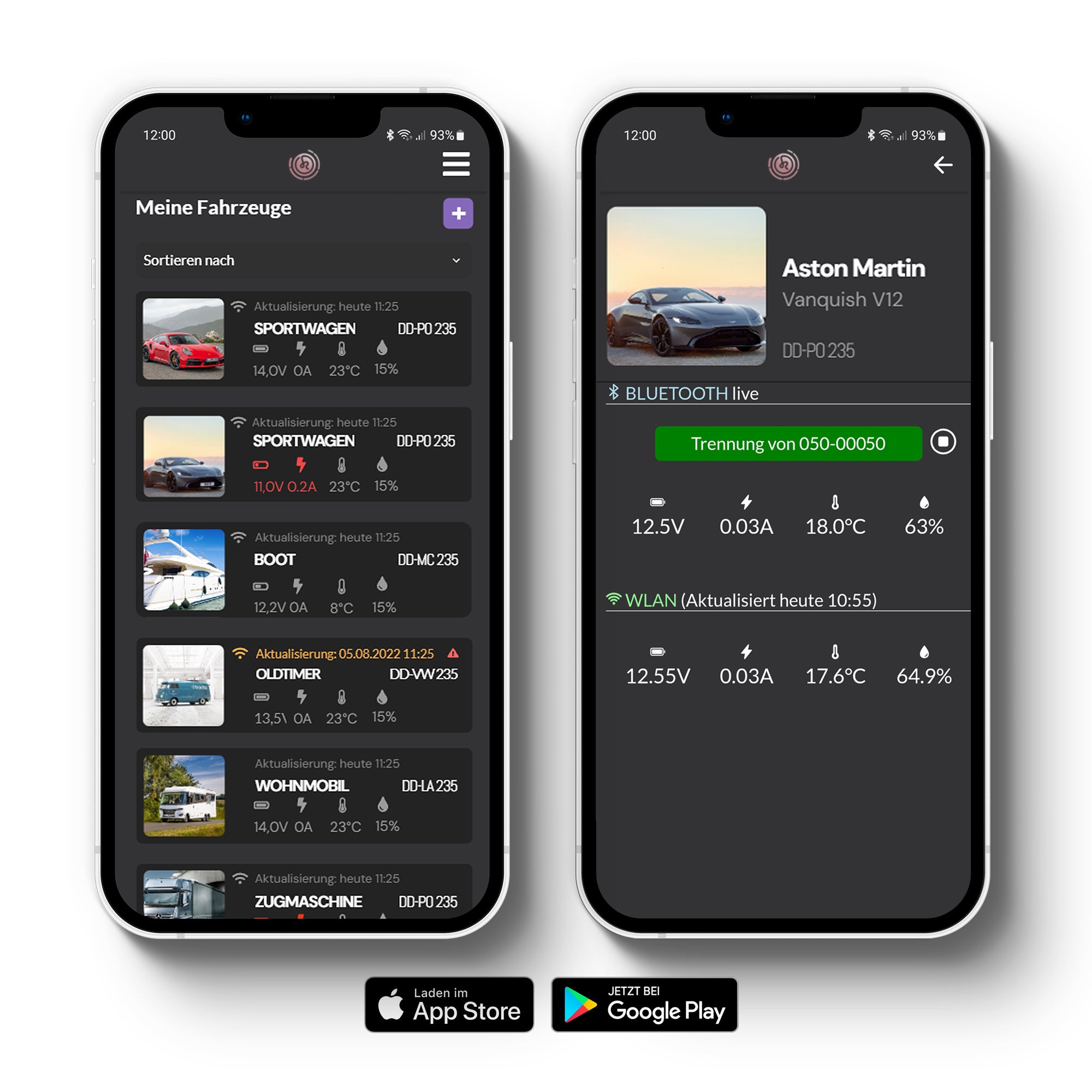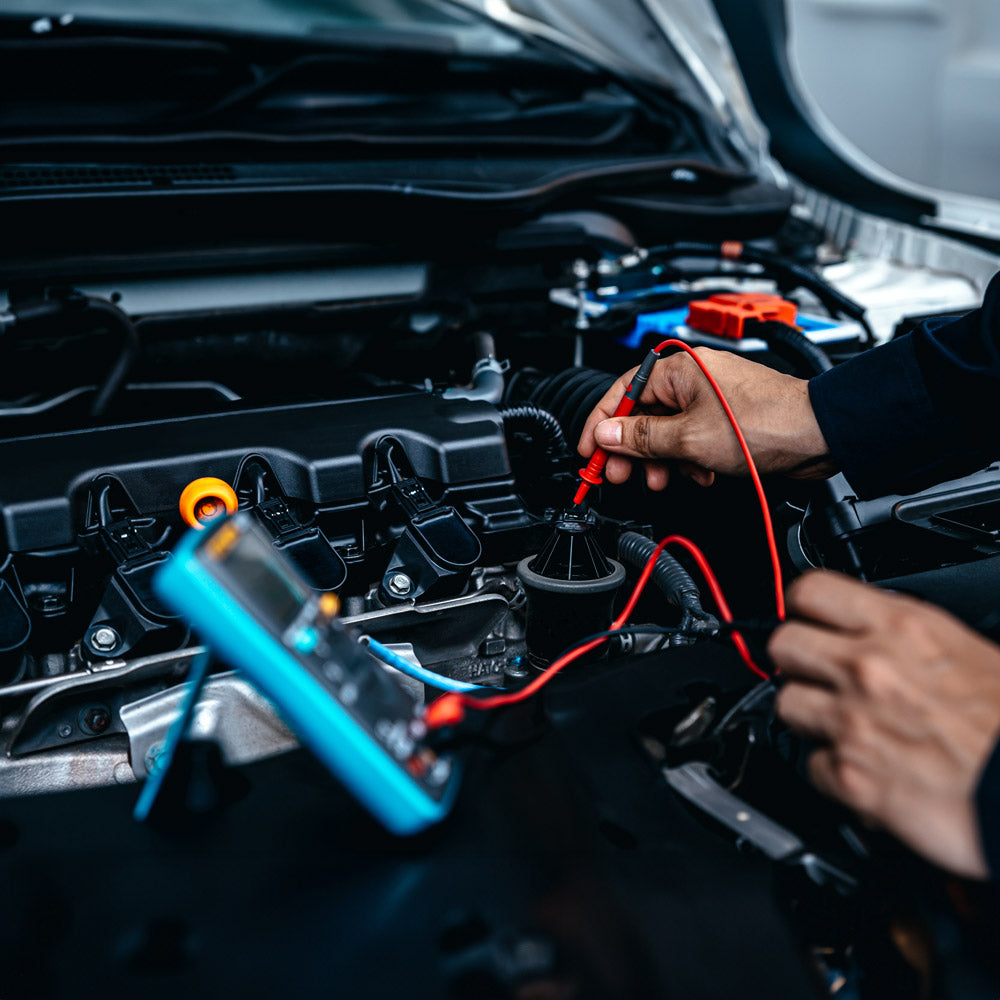

Weshalb eine Fuhrparküberwachung Software für Fahrzeuge sinnvoll ist?
Ein Batteriemonitor für eine Autobatterie ist sinnvoll, um die Gesundheit und Leistung der Batterie zu überwachen. Die Fuhrparkmanagement Software zeigt den aktuellen Ladezustand, die verbleibende Kapazität und die Lade-/Entladeströme an. Dies verhindert unerwartete Batterieausfälle, optimiert die Nutzung und verlängert die Lebensdauer der Fahrzeugbatterie. Solche Software ist besonders nützlich für Fuhrparks und Fuhrparküberwachung.
Weshalb eine Fuhrparküberwachung Software für Fahrzeuge sinnvoll ist?
Ein Batteriemonitor für eine Autobatterie ist sinnvoll, um die Gesundheit und Leistung der Batterie zu überwachen. Die Fuhrparkmanagement Software zeigt den aktuellen Ladezustand, die verbleibende Kapazität und die Lade-/Entladeströme an. Dies verhindert unerwartete Batterieausfälle, optimiert die Nutzung und verlängert die Lebensdauer der Fahrzeugbatterie. Solche Software ist besonders nützlich für Fuhrparks und Fuhrparküberwachung.

Batteriecomputer per WLAN & Bluetooth
Weltweite Datenübertragung kostenlos per WLAN - keine fortlaufenden Mobilfunkkosten
Energie- & Akkuüberwachung
Stromverbrauch (Ampere) und Batteriespannung (Volt) aller Bootsbatterien jederzeit und überall überwachen
Batteriestatus global prüfen
Abruf der Batteriewerte von Ihrem Boot weltweit per App
Umgebungsmonitoring
Erfassung von Umgebungsparametern wie Temperatur, Luftfeuchte und WLAN-Status
.
Produkt

Unser Batterieüberwachungs-system für Ihren Fuhrpark
Ein Batteriewächter für Autos & Fahrzeuge: Alle Vorteile in einem Gerät vereint.
✓ Sicherheitssteigerung: Echtzeitüberwachung der Batterieparameter per Bluetooth-Konnektivität und Temperatursensor verhindert potenzielle Gefahren und erhöht die Sicherheit im Fahrzeug.
✓ Optimierte Energieeffizienz: Präzise Daten vom Batteriemessgerät zur Batterie ermöglichen eine Anpassung der Energieverbrauchsmuster zur Effizienzsteigerung.
✓ Längere Batterielebensdauer: Vermeidung von Über- und Tiefentladung sorgt für eine längere Lebensdauer der Batterien sowie Batterieleistung.
✓ Benutzerfreundlich und zugänglich: WLAN-gestütztes Remote Monitoring und -Steuerung erleichtert die Nutzung, selbst fernab vom Fahrzeug.
✓ Langfristige Kosteneinsparungen: Effizientes Batteriemanagement reduziert Austauschkosten und optimiert den Energieverbrauch, was zu finanziellen Einsparungen führt.
Diese Vorteile sind besonders nützlich für Fuhrpark, Flottenmanagement und die Verwaltung von Fahrzeugflotten in Unternehmen.
Unser Batterieüberwachungs-system für Ihren Fuhrpark
Ein Batteriewächter für Autos & Fahrzeuge: Alle Vorteile in einem Gerät vereint.
✓ Sicherheitssteigerung: Echtzeitüberwachung der Batterieparameter per Bluetooth-Konnektivität und Temperatursensor verhindert potenzielle Gefahren und erhöht die Sicherheit im Fahrzeug.
✓ Optimierte Energieeffizienz: Präzise Daten vom Batteriemessgerät zur Batterie ermöglichen eine Anpassung der Energieverbrauchsmuster zur Effizienzsteigerung.
✓ Längere Batterielebensdauer: Vermeidung von Über- und Tiefentladung sorgt für eine längere Lebensdauer der Batterien sowie Batterieleistung.
✓ Benutzerfreundlich und zugänglich: WLAN-gestütztes Remote Monitoring und -Steuerung erleichtert die Nutzung, selbst fernab vom Fahrzeug.
✓ Langfristige Kosteneinsparungen: Effizientes Batteriemanagement reduziert Austauschkosten und optimiert den Energieverbrauch, was zu finanziellen Einsparungen führt.
Diese Vorteile sind besonders nützlich für Fuhrpark, Flottenmanagement und die Verwaltung von Fahrzeugflotten in Unternehmen.

Batterieüberwachung per WLAN + Automobil Batteriecomputer
Der HOOTS Batterietester mit WLAN und Batteriemonitor bietet eine
innovative Lösung für Autos und Fahrzeuge. Diese fortschrittliche
Technologie ermöglicht eine präzise Kontrolle und Verwaltung der
Batteriesysteme auf einen Blick, was für die sichere und effiziente
Energieversorgung in automobilen Umgebungen entscheidend ist. Besonders
nützlich für den Firmenwagen und die Fuhrpark Verwaltung, bietet die
Flottenmanagement Software einen umfassenden Überblick. Diese
Fuhrparksoftware hilft Fahrern und Managern, die Kosten zu überwachen
und den Zustand der Batterien effizient zu verwalten.

Verwendung in Autos und Fahrzeugen
In automobilen Umgebungen ist effizientes Batteriemanagement unverzichtbar, da die Energieversorgung oft isoliert und entscheidend ist. Ein WLAN-fähiges Batteriemanagementsystem ermöglicht eine bequeme und effektive Nutzung der Energiequellen und sorgt gleichzeitig für maximale Sicherheit und Komfort im Fahrzeug. Fuhrparkmanager und Flottenmanager profitieren von präzisen Daten und modernen Softwarelösungen.
Verwendung in Autos und Fahrzeugen
In automobilen Umgebungen ist effizientes Batteriemanagement unverzichtbar, da die Energieversorgung oft isoliert und entscheidend ist. Ein WLAN-fähiges Batteriemanagementsystem ermöglicht eine bequeme und effektive Nutzung der Energiequellen und sorgt gleichzeitig für maximale Sicherheit und Komfort im Fahrzeug. Fuhrparkmanager und Flottenmanager profitieren von präzisen Daten und modernen Softwarelösungen.

Hauptmerkmale und Vorteile
Batterieüberwachung auf Top-Level
Alle Features und wichtige Funktionen unseres Batteriemanagementsystems für Fahrzeuge im Überblick
WiFi- / WLAN-Verbindung
Ermöglicht das Fernmonitoring und die Steuerung der Batterien über Smartphone, Tablet oder Computer. Nutzer können den Batteriestatus per Batteriemessgerät in Echtzeit prüfen und Einstellungen bequem aus der Ferne ändern. Ideal für den Einsatz in Autos und Firmenwagen, unterstützt es auch die Fuhrparkmanagement Software.
HOOTS Automobil Batteriesensor
Die Technologie bietet detaillierte Einblicke in kritische Batterieparameter wie Spannung, Strom, Ladelevel, Entladezyklen und Temperatur. So lässt sich der Zustand des Akkumulators in Autos, Automobilen und Fahrzeugen exakt überwachen.
HOOTS Echtzeit-Daten und Alarme
Das System als Fuhrparkverwaltung und Flottenüberwachung warnt Nutzer bei kritischen Batteriezuständen wie Überladung, Tiefentladung oder ungewöhnlichen Temperaturänderungen.
HOOTS Datenerfassung und -analyse für Fahrzeuge
Durch die Erfassung und Analyse von Daten können Nutzungstrends der Autobatterie erkannt werden, um die Lebensdauer gezielt zu verlängern. Ein Programm erleichtert die Datenpflege und optimiert die Flottenverwaltung.
Einbindung in bestehende Fahrzeug-Systeme
Das System integriert sich nahtlos in die Energieinfrastrukturen von Autos, einschließlich Solarpanels, Generatoren und Wechselrichtern. Dieses Management-Tool optimiert Prozesse und steht im Mittelpunkt der Fahrzeughardware.

Fahrzeugüberwachung des Fuhrparks in Perfektion
Unsere Lösung für ein Energiemanagementsystem in Autos bietet eine zuverlässige und benutzerfreundliche Möglichkeit, den Batteriezustand zu überwachen.
Dank präziser Echtzeitdaten zu Spannung, Kapazität und Ladezustand stellen Batteriemonitore sicher, dass Ihre Batterien stets optimal arbeiten. Die integrierte Bluetooth-App ermöglicht eine einfache Kontrolle der Daten sowie Fernüberwachung mit direkten Benachrichtigungen auf Ihrem Smartphone.
Diese Fuhrparkmanagement Software ist ideal für die Fuhrparkverwaltung, unterstützt den Fahrzeugpool und Automobile effektiv und verbessert das Flottenmanagement.
Fahrzeugüberwachung des Fuhrparks in Perfektion
Unsere Lösung für ein Energiemanagementsystem in Autos bietet eine zuverlässige und benutzerfreundliche Möglichkeit, den Batteriezustand zu überwachen.
Dank präziser Echtzeitdaten zu Spannung, Kapazität und Ladezustand stellen Batteriemonitore sicher, dass Ihre Batterien stets optimal arbeiten. Die integrierte Bluetooth-App ermöglicht eine einfache Kontrolle der Daten sowie Fernüberwachung mit direkten Benachrichtigungen auf Ihrem Smartphone.
Diese Fuhrparkmanagement Software ist ideal für die Fuhrparkverwaltung, unterstützt den Fahrzeugpool und Automobile effektiv und verbessert das Flottenmanagement.


Echtzeitüberwachung und Benachrichtigungen für Fahrzeugbatterien
Die Software zur Batterieüberwachung mit SmartShunt in Autos liefert präzise Echtzeitdaten zu Spannung, Stromstärke und Ladekapazität Ihrer Akkus. Über eine intuitive Bluetooth-Software auf Ihrem Smartphone haben Sie jederzeit Zugriff auf diese Informationen. Mit einem WLAN Battery Guard behalten Sie stets den Zustand der Systemspannung, Entladung und Batteriekapazität Ihrer Batterien im Auge. Ideal für den Fahrzeugbestand in Unternehmen und Anwendungen im Fuhrparkalltag, erleichtert es die Arbeit und hält Fahrzeugdaten und Fuhrparkdaten stets aktuell.
Echtzeitüberwachung und Benachrichtigungen für Fahrzeugbatterien
Die Software zur Batterieüberwachung mit SmartShunt in Autos liefert präzise Echtzeitdaten zu Spannung, Stromstärke und Ladekapazität Ihrer Akkus. Über eine intuitive Bluetooth-Software auf Ihrem Smartphone haben Sie jederzeit Zugriff auf diese Informationen. Mit einem WLAN Battery Guard behalten Sie stets den Zustand der Systemspannung, Entladung und Batteriekapazität Ihrer Batterien im Auge. Ideal für den Fahrzeugbestand in Unternehmen und Anwendungen im Fuhrparkalltag, erleichtert es die Arbeit und hält Fahrzeugdaten und Fuhrparkdaten stets aktuell.


Erhöhung der Lebensdauer von Fahrzeugbatterien
Durch präzise Überwachung der Batteriezustände und Kapazität mit einem Voltmeter oder Amperemeter können Sie die Nutzung Ihrer Fahrzeugbatterien optimieren und ihre Lebensdauer durch Überladungsschutz verlängern. Rechtzeitige Warnungen bei kritischen Zuständen helfen, Tiefentladungen und andere schädliche Einflüsse zu vermeiden, die die Batterie eines Autos langfristig beschädigen könnten. Dies gewährleistet Kontrolle im Fahrzeug und senkt langfristig die Kosten durch seltener notwendige Batteriewechsel. Flottenmanagement Software und Fuhrparksoftware unterstützen Fuhrparkmanager und Flottenmanager dabei, das Fahrzeugmanagement effizient zu gestalten.
Erhöhung der Lebensdauer von Fahrzeugbatterien
Durch präzise Überwachung der Batteriezustände und Kapazität mit einem Voltmeter oder Amperemeter können Sie die Nutzung Ihrer Fahrzeugbatterien optimieren und ihre Lebensdauer durch Überladungsschutz verlängern. Rechtzeitige Warnungen bei kritischen Zuständen helfen, Tiefentladungen und andere schädliche Einflüsse zu vermeiden, die die Batterie eines Autos langfristig beschädigen könnten. Dies gewährleistet Kontrolle im Fahrzeug und senkt langfristig die Kosten durch seltener notwendige Batteriewechsel. Flottenmanagement Software und Fuhrparksoftware unterstützen Fuhrparkmanager und Flottenmanager dabei, das Fahrzeugmanagement effizient zu gestalten.

Fragen & Antworten
Wissenswertes über unsere Produkte im Bereich Automobile & Fahrzeuge
Wie ist eine Batterie Fernüberwachung möglich?
Eine Batterie-Fernüberwachung in Autos und Fahrzeugen ist durch moderne Fuhrparkmanagement Software möglich. Diese Software ermöglicht es Fuhrparkmanagern, den Zustand der Batterien in allen Automobilen des Fahrzeugbestands in Echtzeit zu überwachen. Wichtige Daten wie Spannung, Ladezustand und Temperatur werden übermittelt, sodass potenzielle Probleme frühzeitig erkannt und Wartungsarbeiten rechtzeitig durchgeführt werden können. Dies trägt zur Verlängerung der Batterielebensdauer und zur Verbesserung der Effizienz des Flottenmanagements bei. Fuhrparkmanagement Software ist somit ein unverzichtbares Tool für eine effektive Kontrolle und Überwachung von Fahrzeugbatterien in Fuhrparks.
Wie funktioniert ein Batterie Management System?
Ein Batterie Management System (BMS) in Autos und Fahrzeugen überwacht und optimiert den Zustand und die Leistung der Batterien. Es erfasst Daten zu Spannung, Strom, Temperatur und Ladezustand pro Fahrzeug, die über eine App in Echtzeit eingesehen werden können. In der Flottensteuerung hilft die Fuhrparkmanagement Software, diese Flottendaten zu analysieren und zu pflegen. Dadurch werden Routen und die Nutzung der Fahrzeugflotte optimiert. Das BMS trägt zur Effizienzsteigerung und Verlängerung der Batterielebensdauer bei. Fuhrparkmanagement Software integriert diese Datenkuratierung in das Fuhrparkmanagement, um eine optimale Verwaltung des Fuhrparks zu gewährleisten.
Wann braucht man ein Batteriemanagementsystem?
Ein Batteriemanagementsystem ist unerlässlich, wenn Sie eine große Fahrzeugflotte betreiben oder ein Unternehmen führen, das auf Mobilität und effiziente Fahrzeugverwaltung angewiesen ist. Solche Systeme helfen als Überblick, die Batterien in allen Autos zu überwachen und zu optimieren. Dies ist besonders wichtig für Fuhrparks, da eine zuverlässige Fahrzeugortung und -verwaltung die Betriebszeit maximiert und Ausfälle minimiert. Mit der richtigen Software können Unternehmen den Zustand der Batterien überwachen, was zu längerer Lebensdauer und effizienterem Betrieb führt. So bleibt die Mobilität Ihrer Fahrzeugflotte stets gewährleistet.
Welche Batterieüberwachung für Fahrzeugflotten und Fuhrparkmanagement?
Für Fuhrparkfahrzeuge und Fuhrparkmanagement ist eine umfassende Batterieüberwachung unerlässlich. Fuhrparkmanagement Unternehmen sollten auf Systeme setzen, die Echtzeitdaten liefern und eine effiziente Flottenkontrolle ermöglichen. Moderne Entwicklungen in der Hardware bieten Automatisierung und präzise Überwachung. Diese Systeme unterstützen die Routenplanung und maximieren die Effizienz der Flotte. Durch die Integration in den Fuhrpark können Unternehmen die Lebensdauer der Batterien verlängern und den Betrieb optimieren. Eine gute Batterieüberwachung ist somit entscheidend für den Erfolg im Fuhrparkmanagement.
Welche Möglichkeiten gibt es zur Fernüberwachung einer 12V Autobatterie?
Zur Fernüberwachung einer 12V Autobatterie gibt es mehrere Möglichkeiten. Moderne Fuhrparksoftware-Lösungen ermöglichen es, den Zustand der Batterie in Echtzeit zu überwachen. Dies ist besonders nützlich für Fuhrparks und Unternehmensflotten, da Fahrer und Manager stets den Überblick über den Batteriestatus behalten können. Ein Vergleich verschiedener Systeme zeigt, dass einige Lösungen auch historische Daten speichern und analysieren, um präventive Wartung zu ermöglichen. Diese Technologien helfen, die Effizienz der Flotte zu maximieren und Ausfälle zu minimieren.
Was ist ein Batteriewächter zur digitalen Fuhrparküberwachung?
Ein Batteriewächter zur digitalen Fuhrparküberwachung ist ein Gerät, das den Zustand und die Leistung der Fahrzeugbatterien überwacht. Es ermöglicht die Optimierung des Batteriemanagements und hilft, die Anforderungen einer effizienten Flotte als Fuhrpark-Management Software zu erfüllen. Fuhrparkmanager erhalten einen umfassenden Überblick über den Batteriestatus aller Fahrzeuge in der Flotte und können potenzielle Probleme frühzeitig erkennen. Dies verbessert die Zuverlässigkeit und reduziert Ausfallzeiten pro Fahrzeug. Fahrer profitieren von einem reibungslosen Betrieb, während der gesamte Fuhrpark des Unternehmens effizienter verwaltet werden kann.
Noch mehr Wissen
Wie lagere ich eine Fahrzeugbatterie richtig?
Hier sind die wichtigsten Tipps für die richtige Lagerung von Fahrzeugbatterien:
-Lagern Sie die Batterie an einem trockenen, gut belüfteten Ort.
-Die ideale Lagertemperatur liegt zwischen 10 und 20 Grad Celsius.
-Lagern Sie die Batterie aufrecht.
-Schützen Sie die Pole mit Plastikfolie oder einem anderen Isoliermaterial.
-Laden Sie die Batterie vor der Lagerung vollständig auf.
-Überprüfen Sie die Batterie regelmäßig auf Schäden.
Wenn Sie diese Tipps befolgen, können Sie dazu beitragen, dass Ihre Fahrzeugbatterie in gutem Zustand bleibt und ihre Lebensdauer verlängert wird.
Wie kann ich feststellen ob eine 12V Autobatterie defekt ist?
Spannung prüfen: Verwenden Sie ein Voltmeter, um die Spannung der 12 Volt
Batterien zu messen. Liegt die Spannung unter 12,4 Volt, könnte ein
Problem vorliegen.
Belastungstest: Ein KFZ Batterie Wächter oder KFZ Batteriewächter kann den Zustand der
Batterie unter Last testen. Fällt die Spannung unter 10 Volt, ist die
Batterie wahrscheinlich defekt.
Visuelle Inspektion: Überprüfen Sie die KFZ Batterie und den Stromkreis auf
sichtbare Schäden oder Korrosion an den Anschlüssen.
Auto Bordcomputer: Nutzen Sie den Auto Bordcomputer zur Kontrolle der KFZ
Batterie.
Wie lange hält in der Regel eine 12V Autobatterie?
Eine 12Volt KFZ Batterie hält in der Regel 4 bis 6 Jahre, abhängig vom Gebrauch und Wartung. Um die Langlebigkeit zu maximieren, sollten Sie die Autobatterie regelmäßig überwachen und vor Entladung schützen. Ein gutes Messgerät mit ausreichender Polkabellänge hilft bei der Datenübertragung und Überprüfung der Spannung. Achten Sie darauf, dass die Entladeschlussspannung nicht unterschritten wird, um Schäden zu vermeiden. Für detaillierte Produktinformationen und optimale Pflegehinweise sollten Sie die Herstellerangaben beachten. Regelmäßige Wartung und Anaylse sind der Schlüssel zur Verlängerung der Batterielebensdauer.

Fahrzeugbatterien absichern und Lebensdauer verlängern
Zum BatteriewächterDHL Versand innerhalb Europas
Versand per DHL auch an Packstation / Postfiliale und europaweit
Kundenservice
Haben Sie Fragen? battery@hoots.de
HOOTS Empfehlen
Sie möchten HOOTS BATTERY auf Ihren Social Media Kanälen z.B. YouTube vorstellen oder vertreiben? battery@hoots.de
Sichere Bezahlmethoden
Apple Pay | Google Pay | PayPal | Klarna Rechnung | Visa | Mastercard | Vorkasse
